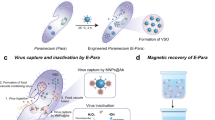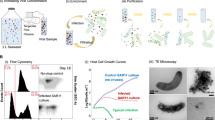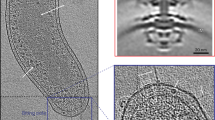Abstract
Predation on bacteria and accompanying mortality are important mechanisms in controlling bacterial populations and recycling of nutrients through the microbial loop. The agents most investigated and seen as responsible for bacterial mortality are viruses and protists. However, a body of evidence suggests that predatory bacteria such as the Halobacteriovorax (formerly Bacteriovorax), a Bdellovibrio-like organism, contribute substantially to bacterial death. Until now, conclusive evidence has been lacking. The goal of this study was to better understand the contributors to bacterial mortality by addressing the poorly understood role of Halobacteriovorax and how their role compares with that of viruses. The results revealed that when a concentrated suspension of Vibrio parahaemolyticus was added into microcosms of estuarine waters, the native Halobacteriovorax were the predators that responded first and most rapidly. Their numbers increased by four orders of magnitude, whereas V. parahaemolyticus prey numbers decreased by three orders of magnitude. In contrast, the extant virus population showed little increase and produced little change in the prey density. An independent experiment with stable isotope probing confirmed that Halobacteriovorax were the predators primarily responsible for the mortality of the V. parahaemolyticus. The results show that Halobacteriovorax have the potential to be significant contributors to bacterial mortality, and in such cases, predation by Halobacteriovorax may be an important mechanism of nutrient recycling. These conclusions add another dimension to bacterial mortality and the recycling of nutrients.
Similar content being viewed by others

Log in or create a free account to read this content
Gain free access to this article, as well as selected content from this journal and more on nature.com
or
References
Ahmed M . (2007). Isolation, characterization and possible biocontrol application of Bdellovibrionaceae (BD) isolated from NZ sources. Doctoral Thesis, Institute of Technology and Engineering, Massey University.
Amaral-Zettler L, Artigas LF, Baross J, Bharathi L, Boetius A, Chandramohan D et al. (2010). A global census of marine microbes. Life in the world’s Oceans: Diversity, Distribution and Abundance. Blackwell Publishing Ltd: Oxford, 223–245.
Azam F, Long RA . (2001). Oceanography: sea snow microcosms. Nature 414: 495–498.
Baross JA, Liston J, Morita RY . (1978). Incidence of Vibrio parahaemolyticus bacteriophages and other Vibrio bacteriophages in marine samples. Appl Environ Microbiol 36: 492–499.
Blackburn N, Fenchel T, Mitchell J . (1998). Microscale nutrient patches in planktonic habitats shown by chemotactic bacteria. Science 282: 2254–2256.
Chauhan A, Williams HN . (2006). Response of Bdellovibrio and like organisms (BALOs) to the migration of naturally occurring bacteria to chemoattractants. Curr Microbiol 53: 516–522.
Chen F, Lu JR, Binder BJ, Liu YC Hodson RE . (2001). Application of digital image analysis and flow cytometry to enumerate marine viruses stained with SYBR Gold. Appl Environ Microbiol 67: 539–545.
Chen H, Athar R, Zheng G, Williams HN . (2011). Prey bacteria shape the community structure of their predators. ISME J 5: 1314–1322.
Crothers‐Stomps C, Høj L, Bourne D, Hall M, Owens L . (2010). Isolation of lytic bacteriophage against Vibrio harveyi. J Appl Microbiol 108: 1744–1750.
Davidov Y, Friedjung A, Jurkevitch E . (2006). Structure analysis of a soil community of predatory bacteria using culture-dependent and culture-independent methods reveals a hitherto undetected diversity of Bdellovibrio-and-like organisms. Environ Microbiol 8: 1667–1673.
Deng L, Gregory A, Yilmaz S, Poulos BT, Hugenholtz P, Sullivan MB . (2012). Contrasting life strategies of viruses that infect photo-and heterotrophic bacteria, as revealed by viral tagging. MBio 3: doi:10.1128/mBio.00373-12.
Fenton A, Kanna M, Woods R, Aizawa S-I, Sockett R . (2010). Shadowing the actions of a predator: backlit fluorescent microscopy reveals synchronous nonbinary septation of predatory Bdellovibrio inside prey and exit through discrete bdelloplast pores. J Bacteriol 192: 6329–6335.
Froelich B, Williams T, Noble RT, Oliver JD . (2013). Apparent loss of Vibrio vulnificus in North Carolina oysters coincides with drought-induced increase in salinity. Appl Environ Microbiol 78: 3885–3889.
Fuhrman JA, Noble RT . (1995). Viruses and protists cause similar bacterial mortality in coastal seawater. Limnol Oceanogr 40: 1236–1242.
Fuhrman JA . (1999). Marine viruses and their biogeochemical and ecological effects. Nature 399: 541–548.
Fuhrman JA . (2009). Microbial community structure and its functional implications. Nature 459: 193–199.
Guixa-Boixereu N, Lysnes K, Pedrós-Alió C . (1999). Viral lysis and bacterivory during a phytoplankton bloom in a coastal water microcosm. Appl Environ Microbiol 65: 1949–1958.
Hamdan LJ, Jonas RB . (2006). Seasonal and interannual dynamics of free-living bacterioplankton and microbially labile organic carbon along the salinity gradient of the Potomac River. Estuar Coast 29: 40–53.
Harvey R, Young L . (1980). Enrichment and association of bacteria and particulates in salt marsh surface water. Appl Environ Microbiol 39: 894–899.
Johnke J, Cohen Y, de Leeuw M, Kushmaro A, Jurkevitch E, Chatzinotas A . (2014). Multiple micro-predators controlling bacterial communities in the environment. Curr Opin Biotechnol 27: 185–190.
Koval SF, Williams HN, Stine OC . (2014). Reclassification of Bacteriovorax marinus as Halobacteriovorax marinus gen. nov., comb. nov. and Bacteriovorax litoralis as Halobacteriovorax litoralis comb. nov.; description of Halobacteriovoraceae fam. nov. in the class Deltaproteobacteria. Int J Syst Evol Microbiol 0: 070201–070200.
Lambert C, Fenton AK, Hobley L, Sockett RE . (2011). Predatory Bdellovibrio bacteria use gliding motility to scout for prey on surfaces. J Bacteriol 193: 3139–3141.
Li H, Liu C, Chen L, Zhang X, Cai J . (2011). Biological characterization of two marine Bdellovibrio-and-like organisms isolated from Daya bay of Shenzhen, China and their application in the elimination of Vibrio parahaemolyticus in oyster. Int J Food Microbiol 151: 36–43.
Li H, Chen C, Sun Q, Liu R, Cai J . (2014). Bdellovibrio and like organisms enhanced growth and survival of penaeus monodon and altered bacterial community structures in its rearing water. Appl Environ Microbiol 80: 6346–6354.
Middelboe M, Jorgensen N, Kroer N . (1996). Effects of viruses on nutrient turnover and growth efficiency of noninfected marine bacterioplankton. Appl Environ Microbiol 62: 1991–1997.
Murray AG, Jackson GA . (1992). Viral dynamics: a model of the effects of size, shape, motion and abundance of single-celled planktonic organisms and other particles. Mar Ecol Prog Ser 89: 103–116.
Muyzer G, Teske A, Wirsen C, Jannasch H . (1995). Phylogenetic relationships of Thiomicrospira species and their identification in deep-sea hydrothermal vent samples by denaturing gradient gel electrophoresis of 16S rDNA fragments. Arch Microbiol 164: 165–172.
Padmanabhan P, Padmanabhan S, DeRito C, Gray A, Gannon D, Snape J et al. (2003). Respiration of 13C-labeled substrates added to soil in the field and subsequent 16S rRNA gene analysis of 13C-labeled soil DNA. Appl Environ Microbiol 69: 1614–1622.
Pedrós-Alió C . (2006). Marine microbial diversity: can it be determined? Trends Microbiol 14: 257–263.
Pineiro SA, Sahaniuk GE, Romberg E, Williams HN . (2004). Predation pattern and phylogenetic analysis of Bdellovibrionaceae from the Great Salt Lake, Utah. Curr Microbiol 48: 113–117.
Pineiro SA, Stine OC, Chauhan A, Steyert SR, Smith R, Williams HN . (2007). Global survey of diversity among environmental saltwater Bacteriovoracaceae. Environ Microbiol 9: 2441–2450.
Proctor LM, Fuhrman JA . (1990). Viral mortality of marine bacteria and cyanobacteria. Nature 343: 60–62.
Rice TD, Williams HN, Turng BF . (1998). Susceptibility of bacteria in estuarine environments to autochthonous bdellovibrios. Microb Ecol 35: 256–264.
Richards GP, Fay JP, Dickens KA, Parent MA, Soroka DS, Boyd EF . (2012). Predatory bacteria as natural modulators of Vibrio parahaemolyticus and Vibrio vulnificus in seawater and oysters. Appl Environ Microbiol 78: 7455–7466.
Richards GP, Watson MA, Boyd EF, Burkhardt W, Lau R, Uknalis J et al. (2013). Seasonal levels of the Vibrio predator bacteriovorax in atlantic, pacific, and gulf coast seawater. Int J Microbiol 2013: 375371.
Sewell LM, Bitton G, Bays JS . (1981). Evaluation of membrane adsorption-epifluorescence microscopy for the enumeration of bacteria in coastal surface films. Microb Ecol 7: 365–369.
Starr MP, Baigent NL . (1966). Parasitic interaction of Bdellovibrio bacteriovorus with other bacteria. J Bacteriol 91: 2006–2017.
Stocker R, Seymour JR, Samadani A, Hunt DE, Polz MF . (2008). Rapid chemotactic response enables marine bacteria to exploit ephemeral microscale nutrient patches. Proc Natl Acad Sci USA 105: 4209–4214.
Sutton D, Besant P . (1994). Ecology and characteristics of bdellovibrios from three tropical marine habitats. Mar Biol 119: 313–320.
Taylor VI, Baumann P, Reichelt JL, Allen RD . (1974). Isolation, enumeration, and host range of marine Bdellovibrios. Arch Microbiol 98: 101–114.
Tsai A, Gong G-C, Hung J . (2013). Seasonal variations of virus-and nanoflagellate-mediated mortality of heterotrophic bacteria in the coastal ecosystem of subtropical western Pacific. Biogeosciences 10: 3055–3065.
Varon M, Shilo M . (1980). Ecology of aquatic bdellovibrios. Adv Aquat Microbiol 2: 1–48.
Villa AA, Kropinski AM, Abbasifar R, Abbasifar A, Griffiths MW . (2012). Genome sequence of temperate Vibrio parahaemolyticus bacteriophage vB_VpaS_MAR10. J Virol 86: 13851–13852.
Weinbauer MG, Suttle CA . (1996). Potential significance of lysogeny to bacteriophage production and bacterial mortality in coastal waters of the gulf of Mexico. Appl Environ Microbiol 62: 4374–4380.
Weinbauer MG, Höfle MG . (1998). Significance of viral lysis and flagellate grazing as factors controlling bacterioplankton production in a eutrophic lake. Appl Environ Microbiol 64: 431–438.
Weitz JS, Stock CA, Wilhelm SW, Bourouiba L, Coleman ML, Buchan A et al. (2015). A multitrophic model to quantify the effects of marine viruses on microbial food webs and ecosystem processes. ISME J.
Wen C, Xue M, Liang H, Zhou S . (2014). Evaluating the potential of marine Bacteriovorax sp. DA5 as a biocontrol agent against vibriosis in Litopenaeus vannamei larvae. Vet Microbiol 173: 84–91.
Wilcox RM, Fuhrman JA . (1994). Bacterial viruses in coastal seawater: lytic rather than lysogenic production. Mar Ecol Prog Ser 114: 35–35.
Williams H . (1987). The recovery of high numbers of bdellovibrios from the surface water microlayer. Can J Microbiol 33: 572–575.
Williams H . (1988). A study of the occurrence and distribution of bdellovibrios in estuarine sediment over an annual cycle. Microb Ecol 15: 9–20.
Williams HN . (1979). Cultural, immunologic and ecologic studies of marine bdellovibrios isolated from the Atlantic Ocean and the Chesapeake Bay. PhD thesis, University of Maryland: Baltimore, MD, USA.
Acknowledgements
We acknowledge the help of Cynthia Wang for her participation in preliminary experiments and editing of earlier versions of the manuscript. We gratefully acknowledge the support received from NSF grant nos. OCE 0455276, HRD 0932137, HRD 1056890 and NSF/NIH Ecology of Infectious Disease Program OCE 0812913.
Author information
Authors and Affiliations
Corresponding author
Ethics declarations
Competing interests
The authors declare no conflict of interest.
Additional information
Supplementary Information accompanies this paper on The ISME Journal website
Supplementary information
Rights and permissions
About this article
Cite this article
Williams, H., Lymperopoulou, D., Athar, R. et al. Halobacteriovorax, an underestimated predator on bacteria: potential impact relative to viruses on bacterial mortality. ISME J 10, 491–499 (2016). https://doi.org/10.1038/ismej.2015.129
Received:
Revised:
Accepted:
Published:
Issue date:
DOI: https://doi.org/10.1038/ismej.2015.129
This article is cited by
-
Mortality by ribosomal sequencing (MoRS) provides a window into taxon-specific cell lysis
The ISME Journal (2023)
-
Disentangling the Ecological Processes and Driving Forces Shaping the Seasonal Pattern of Halobacteriovorax Communities in a Subtropical Estuary
Microbial Ecology (2023)
-
Oceanospirillales containing the DMSP lyase DddD are key utilisers of carbon from DMSP in coastal seawater
Microbiome (2022)
-
Community and single cell analyses reveal complex predatory interactions between bacteria in high diversity systems
Nature Communications (2021)
-
Bradymonabacteria, a novel bacterial predator group with versatile survival strategies in saline environments
Microbiome (2020)


